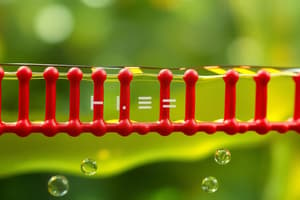Podcast
Questions and Answers
Which equation accounts for both the chemical and electrical driving forces that act on an ion?
Which equation accounts for both the chemical and electrical driving forces that act on an ion?
- Henderson-Hasselbalch equation
- Van't Hoff equation
- Arrhenius equation
- Nernst equation (correct)
What will be the direction of an ion when the membrane potential is at its equilibrium potential?
What will be the direction of an ion when the membrane potential is at its equilibrium potential?
- Movement into the cell
- Movement out of the cell
- No net movement (correct)
- Alternating movement in and out of the cell
What generates the resting membrane potential?
What generates the resting membrane potential?
- Neurotransmitter release
- Differential ion concentrations across the membrane (correct)
- Action potential firing
- Cell division
Which equation is used to understand the basis of membrane potential in reference to ion permeabilities?
Which equation is used to understand the basis of membrane potential in reference to ion permeabilities?
What type of conduction is characterized by passive, local, graded potentials?
What type of conduction is characterized by passive, local, graded potentials?
Which type of conduction is associated with myelinated axons and is a solution to energy and speed issues?
Which type of conduction is associated with myelinated axons and is a solution to energy and speed issues?
What accounts for the absolute refractory period during action potential propagation?
What accounts for the absolute refractory period during action potential propagation?
Which mechanism turns different kinds of stimuli into action potentials in the nervous system?
Which mechanism turns different kinds of stimuli into action potentials in the nervous system?
What is the consequence of demyelinating diseases on action potential propagation frequency?
What is the consequence of demyelinating diseases on action potential propagation frequency?
What determines the size of a graded potential?
What determines the size of a graded potential?
What type of potential is responsible for coding intensity in sensory systems?
What type of potential is responsible for coding intensity in sensory systems?
Which type of conduction is characterized by a decrease in action potential propagation frequency in demyelinating diseases?
Which type of conduction is characterized by a decrease in action potential propagation frequency in demyelinating diseases?
Flashcards are hidden until you start studying
Study Notes
Ion Movement and Membrane Potential
- The Goldman equation accounts for both the chemical and electrical driving forces that act on an ion.
- When the membrane potential is at its equilibrium potential, the direction of an ion is zero, meaning there is no net movement of ions.
Generation of Resting Membrane Potential
- The resting membrane potential is generated by the unequal distribution of ions across the cell membrane.
Ion Permeabilities and Membrane Potential
- The Goldman-Hodgkin-Katz equation is used to understand the basis of membrane potential in reference to ion permeabilities.
Conduction Types
- Electrotonic conduction is characterized by passive, local, graded potentials.
- Saltatory conduction is associated with myelinated axons and is a solution to energy and speed issues.
Action Potential Propagation
- The absolute refractory period during action potential propagation is accounted for by the inactivation of sodium channels.
Mechanisms of Action Potentials
- The transduction mechanism turns different kinds of stimuli into action potentials in the nervous system.
Effects of Demyelination
- Demyelinating diseases result in a decrease in action potential propagation frequency.
- In demyelinating diseases, the consequence is a decrease in action potential propagation frequency.
Graded Potentials
- The size of a graded potential is determined by the strength of the stimulus.
- Graded potentials are responsible for coding intensity in sensory systems.
Studying That Suits You
Use AI to generate personalized quizzes and flashcards to suit your learning preferences.




